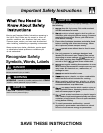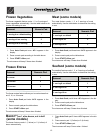
4
Important Safety Instructions
SAVE THESE INSTRUCTIONS
Federal
Communications
Commission Radio
Frequency Interference
Statement (U.S.A. Only)
WARNING
WARNING
To avoid risk of electrical shock or death, this oven must
be grounded and plug must not be altered.
a. A short power-supply cord is provided to reduce the
risks resulting from becoming entangled in or
tripping over a longer cord.
b. Extension cords may be used if care is exercised in
their use.
c. If an extension cord is used:
1. The marked electrical rating of the cord set or
extension cord set should be at least as great as
the electrical rating of the appliance.
2. The extension cord must be a grounding-type 3-
wire cord.
3. The longer cord should be arranged so that it will
not drape over the countertop or tabletop where it
can be tripped over, snagged, or pulled on
unintentionally.
If you use an extension cord, the interior light may flicker
and the blower sound may vary when the microwave oven
is on. Cooking times may be longer, too.
Oven MUST be grounded.
Grounding reduces risk of electric
shock by providing an escape wire
for the electric current if an electrical
short occurs. This oven is equipped
with a cord having a grounding wire with a grounding
plug. The plug must be plugged into an outlet that is
properly installed and grounded. See Installation
Instructions.
Consult a qualified electrician or servicer if grounding
instructions are not completely understood, or if doubt
exists as to whether the oven is properly grounded.
Do not use an extension cord. If the product power
cord is too short, have a qualified electrician install a
three-slot receptacle. This oven should be plugged into a
separate 60 hertz circuit with the electrical ratting as
shown in specifications table. When the oven is on a
circuit with other equipment, an increase in cooking times
may be required and fuses can be blown.
Microwave operates on standard household current, 110-
120V.
Grounding Instructions
This equipment generates and uses ISM frequency energy
and if not installed and used properly, that is in strict
accordance with the manufacturer’s instructions, may
cause interference to radio and television reception. It has
been type tested and found to comply with limits for ISM
Equipment, pursuant to part 18 of FCC Rules, which are
designed to provide reasonable protection against such
interference in a residential installation.
However, there is no guarantee that interference will not
occur in a particular installation. If this equipment does
cause interference to radio or television reception, which
can be determined by turning the equipment off and on,
the user is encouraged to try to correct the interference by
one or more of the following:
Ÿ Reorient the receiving antenna of the radio or
television.
Ÿ Relocate the microwave oven with respect to the
receiver.
Ÿ Move the microwave oven away from the receiver.
Ÿ Plug the microwave oven into a different outlet so that
the microwave oven and the receiver are on different
branch circuits.
The manufacturer is not responsible for any radio or
television interference caused by unauthorized
modification to this microwave oven. It is the responsibility
of the user to correct such interference.


















